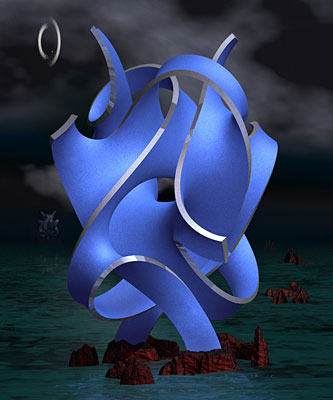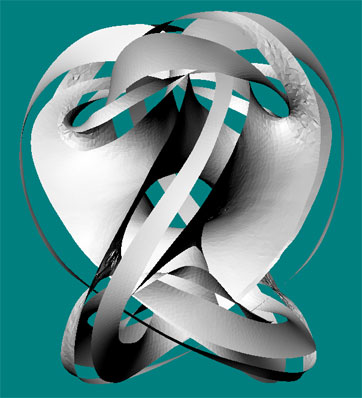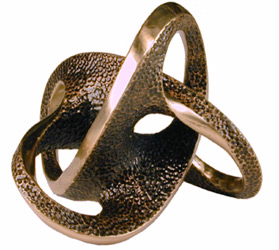A diary of this sculpture from idea to final form, written from bottom to top. The current version is made by direct metal printing.
October 2, 2002

In metal at last! The electroforming experiment was a success, and here is the Objet model from below, coated with about a millimeter of copper. I'm happy with this outcome: this piece is strong, light and durable. The metal is quite solid and nonporous, and the copper patinated easily with moderate heat.
September 27, 2002

Antipot has reached its final form, and I buffed up the Bryce render for fun.
Getting this piece into bronze isn't going so well. I had a ZCorp model made, and from it a rather warped casting, but it looks like it isn't going to salvage.
Meanwhile, as an experiment I'm having the stereolithography model shown below electroformed with copper. Electroforming works like electroplating, in that the piece is coated with conductive paint and then immersed in a bath of metal ions. But the coating laid down is much thicker, so that the metal becomes structural rather than just a finish coat. Nobody seems to have any clear idea whether this process will work for this piece; the question is whether the coating will be uniform enough.
July 15, 2002


Back to the drawing board. At left above, a model made from the draft illustrated below; this is how the Objet part came out. I don't ordinarily get models of this type, as they aren't very beautiful in themselves, and they can't be cast directly into metal. I have this one only because the piece placed in a contest in 2001.
Of course, now that I see the piece offscreen for the first time, revisions are required. At right above is a snapshot from Evolver, showing the piece with its supports in place. I've added these supports because I'm ready to move towards a model for bronze casting, and it must not break before it gets to the foundry.
By popular demand I've retained the working title of this piece, Antipot: everyone likes it better, and in the end I do too.
June 17, 2002

This render shows Antipot in its first final draft, if that makes sense. Continuing to work with Evolver, I've located the edges, added thickness, given them the right bevels, and resolved how the piece will stand.
It's time to move towards physical objects. As I write this a 4" stereolithography model is being built on an Objet printer, and I'm also making a 2" model on my Solidscape machine, which I'll have cast in silver. If all goes well - no major prototyping or casting issues - from there I should be able to move towards larger instances in bronze.
The working title for this piece was "Antipot", because it refuses to contain anything - indeed, it refutes the very idea of containment. Tentative decision on the final title: Ever.
May 20, 2002
It's getting there...below are two views of a
surface without thickness. This is much simpler than the
previous, but the essential interest of it is there. At this stage the
topology is in place, but the edges are still floating around
considerably. I'm using Surface Evolver at every stage,
controlling it carefully to make it put the surface where I want, while
still giving it the grace that minimal-energy surfaces have.

May 5, 2002
Looking at variants of the
Trinon design. In this one I've exploded it so the interior
becomes visible. It's too busy and hard to read, but
something interesting is lurking around here. Connectivity is a
problem: it keeps trying to fall apart into two pieces, which
must be prevented because then it would be unbuildable.

April 24, 2002
Lately I've been working with a mathematical research
tool, Surface Evolver, which iteratively evolves a meshed
surface towards its minimal surface tension. It seems that some
of what I do is pretty closely related to minimal surfaces: Antichron, for instance, is within
2% of the minimal energy for its edges.

I had never been able to model Trinon in CAD before - it wasn't difficult to lay down the edges, but smoothing the large surface through the middle was beyond me. However it wasn't difficult to make a crude approximation of the surface, with the correct topology but not smooth. Such a model is shown above right.
Guessing that the sculpture might be at or near a minimal-energy surface, I set Evolver to work on minimizing the energy of the jagged model. The result is above left: as the surface approaches minimal energy, it also approaches the sculpture. It was quite eerie to watch, as the piece pulled itself into shape without human intervention.
Because Evolver isn't especially adapted to work with Rhinoceros, nor is it naturally a sculpture tool, I had to write a lot of boring software to make this work: format converters, gadgets to find edges, mesh thickeners and so forth.
April 1, 2002
Below is a handmade Trinon, several years old now. I have a feeling something more could be done with this.
